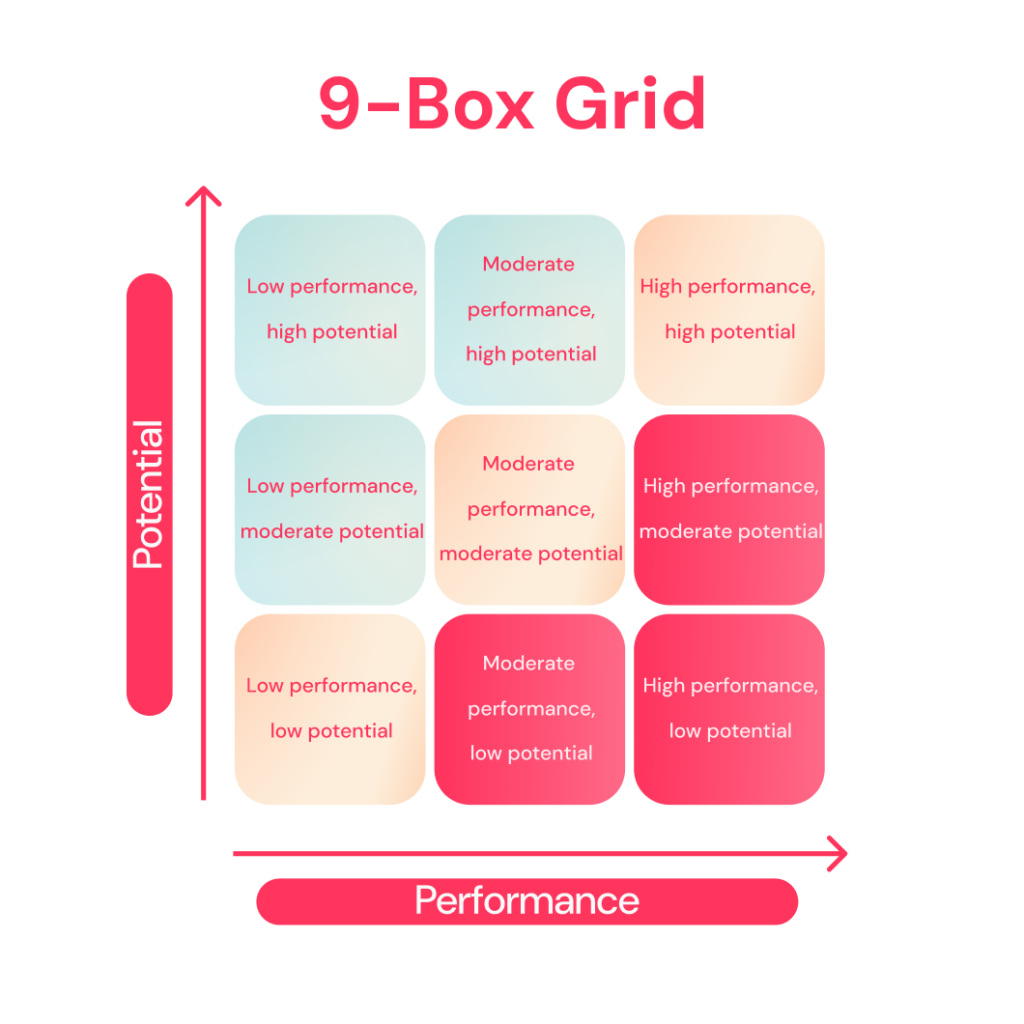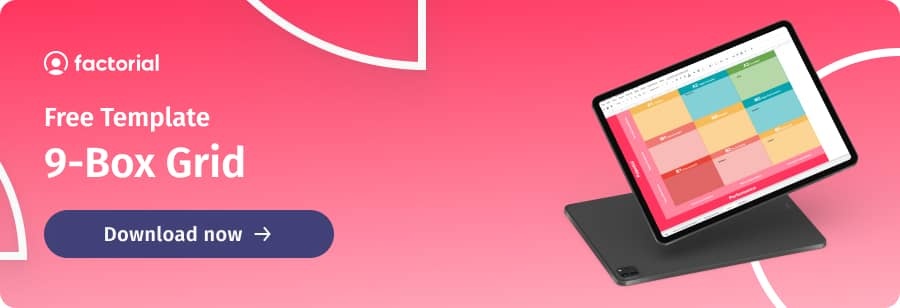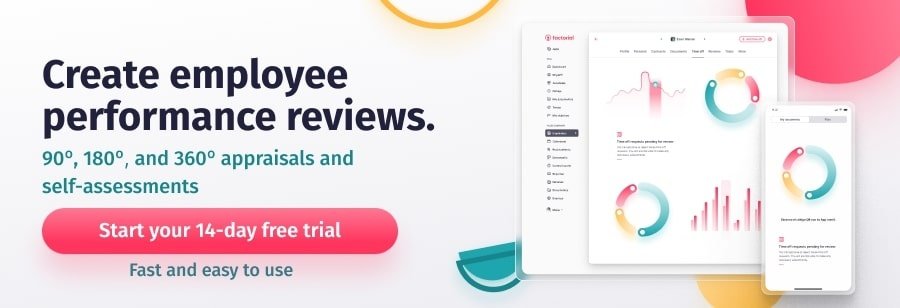The way we measure employee performance is changing. Instead of focusing on employee behaviour, companies must evaluate employee based outcomes with clear performance metrics. As a result, Tools like the 9 box grid help you and your team with talent mapping and performance evaluation.
Using the 9 box for talent review is easy. Try it for yourself after reading this article! Download our free template at the bottom of this page to get started.
In this guide, we will explain what the 9 box is and how it can be used as part of your performance management process. We will also discuss the pros and cons of conducting a 9 box assessment to help you decide if it is the right tool for you.

What is the 9 box in talent management?
The 9 box grid is a talent management and evaluation tool that can help you review employee performance and identify areas for growth and improvement.
McKinsey developed this assessment method in the 1970s to help General Electric prioritize investments across its 150 business units. The McKinsey 9 box talent matrix has evolved since then into an HR management tool used to measure two factors: performance and potential.
9 box for succession planning
The 9 box grid is a valuable tool for succession planning, particularly in identifying and developing talent for leadership. By assessing employees based on both their performance and potential, the grid helps pinpoint individuals who are not only excelling in their current roles but also have the capacity to take on more significant responsibilities in the future.
In succession planning, the focus is often on identifying and nurturing “stars” – those employees who score high in both performance and potential. These stars represent the future leaders who will drive the organization forward.
The 9 box grid serves as a visual representation of the organization’s talent pipeline, mapping out critical roles and identifying top employees who are well-suited to fill these positions. When vacancies arise in key roles, organizations can refer to the grid to quickly identify potential successors, ensuring a smooth transition and continuity in leadership.
Developing talent with 9 box
Once identified, these high-potential employees can be developed for more senior leadership positions within the organization through targeted development plans. This may include participation in leadership development programs, one-on-one coaching sessions, mentorship opportunities, regular feedback mechanisms such as 360-degree reviews, and other tailored development initiatives aimed at maximizing their leadership capabilities.
The 9 box grid is an indispensable tool for succession planning, enabling organizations to proactively identify, nurture, and deploy their leadership talent to drive long-term success and resilience.
Want a quick explanation? Watch this video that how to use Factorial’s 9 box grid.
How does the 9 box assessment work?
With the 9 box talent review grid, you map your employees against two axes:
current performance and future potential
Where employees fall on the grid will depend on their combined scores.
The higher the score, the more potential for growth.
This information can then be used to strategically develop employees for future positions within the company.
9 Box Performance Management: Using the Results
With the results of the 9 box exercise you can determine:
- Which of your employees are ready to lead.
- You can then prepare them for promotion.
- Which employees are not yet ready for a management role but could be in the future.
- Establish the path for the right career development with training needs analysis.
- Which employees are falling short of expectations in their current role.
- You can then create a performance improvement plan and set clear objectives to help them get back on track.
How the 9 box assessment helps employee development
Employees in different quadrants of the grid may require different development initiatives. High performers with high potential may benefit from leadership development programs, stretch assignments, and mentoring opportunities to prepare them for future leadership roles. Employees with high potential but lower current performance may need targeted training and development to improve their skills and performance.
How to Use 9 Box Grid
The grid is a simple three-by-three framework that you can use as part of the performance evaluation process.
You can use this framework to plot employees’ future potential on the y-axis (high potential, moderate potential, low potential) and their current performance on the x-axis (low performer, moderate performer, high performer) according to their combined performance scores.
Where they fall on the grid determines their future within your organization.

9 Box Grid Explained
Now that you know what the grid can be used for, let’s take a look at how you can start working with the grid.
Evaluate Employee Performance
Before you use the grid, you need to assess employee performance. To do this, you can use tools for measuring performance including:
- KPIs
- Performance appraisals
- Salary reviews
- 360-degree feedback
- Personal development plans
- Reward and recognition programs
Depending on the results obtained from the assessment tools, determine whether employees are low, moderate, or high performers. This three-point scale will appear as the x-axis of your nine-box.
Evaluate Employee Potential
The other axis on the diagram is employee potential.
Using performance appraisals, a 360 review template, or other assessment tools previously mentioned, you can get an idea of the potential that employees have to grow in the company.
It is important that you take into account motivation levels and desire to learn. Like performance, you will need to note whether employees have a high, moderate, or low amount of potential.
Position on the Grid
After scoring employee performance and potential, it is time to put it all together in the nine-box grid. You can draw out the nine-box by hand or, to make things easier, use an excel template.
Employees should fall into one of nine categories.
It should look something like this:
The template grid consists of the following categories:
- Enigma: Low performer with high potential
- High potential: Moderate performer with high potential
- Excellent:High performer with high potential
- Questionable: Low performer with moderate potential
- Reliable: Moderate performer with moderate potential
- High performer: High performer with moderate potential
- Unacceptable: Low performer with low potential
- Acceptable: Moderate performer with low potential
- Dedicated: High performer with low potential
Next Step: 9 Box Grid Analysis
Once you determine an employee’s position on the 9-box, you have a frame of reference for deciding how their future at your company will look, and where you need to invest your efforts.
In general, this includes:
- Recognize high-performing employees
- Support mid-range performers to help them improve their performance and move higher up the grid
- Identify employees who consistently underperform and develop a performance improvement plan to train them
The top right of the grid is the optimum spot. That is where top performers sit on the 9 grid.
Free 9 box Grid Template: Download Now
Interested?
Why not give our handy downloadable 9-box grid template a go to see what you think?
9 Box Assessment Benefits
Although there are a number of benefits to holding regular performance appraisals, using this assessment method can provide a deeper level of insight into the level of employee performance in your company.
9 Reasons to Use a 9 box:
- Many companies are now distancing themselves from traditional annual performance reviews as they are costly and do not offer a true representation of an employee’s performance.
- The 9 box gives you a much more rounded and up-to-date perspective. This is because you can use it to evaluate both current performance and potential, so it gives you a much clearer picture of each employee’s performance. It helps you deliver more relevant recognition and more appropriate support, which improves employee morale.
- The tool is quick to set up and easy to use. You just have to review an employee’s strengths and weaknesses to match them with the right box.
- The visual nature of the 9 box method makes it much easier for you to see where you have gaps in your talent pool.
- It encourages dialogue, collaboration, and communication between managers.
- The framework makes it much easier for you to plan for business continuity and employee growth. It’s a valuable tool for your career development plans that can help take your business to the next level.
- As an assessment tool, it can give you a fresh perspective on the level of performance in your company.
- Another benefit is that is makes workforce planning easier. Plus, it highlights development opportunities or training needs, facilitates employee growth and contributes to retention, engagement, and productivity.
- Finally, it increases transparency. The 9 box grid requires open and honest communication between managers. These conversations can often help clarify company goals and expectations.
9 Box Grid: Limitations of the Evaluation Method
Every great management tool has its limitations, and the nine box grid is no exception.
For example, here are some limitations to consider:
- It is a great tool for getting a broad overview of an employee. However, it doesn’t go into any details about an employee’s performance or potential. You also need to rely on additional assessment tools to get a complete perspective of an employee’s performance. This includes regular personal appraisals, 360 feedback, and performance development plans, amongst other tools.
- There are some concerns about how accurate and clear metrics are. This is because it is very difficult for your managers to objectively measure ‘potential’ as it is so clearly linked with ‘performance’. There is also a subjective element here, as one manager’s concept of high potential may differ greatly from the opinions of another. If you decide to use the 9 box assessment model, you need to make sure all managers are clear on how potential is defined and measured.
- The 9 box can also be susceptible to bias. This is because there is a danger that once a label of “high performer” or “low performer” has been assigned to an employee, it can be difficult to unstick. Without clear guidelines, these labels can affect the degree of support and recognition an employee receives.
Tools for Talent Management
The 9 box model is a great tool for getting an overview of an employee’s performance, but to get a better picture of employee performance you need a comprehensive performance management system.
But why is this so important?
A good employee performance management system helps you track and evaluate employee performance against established KPIs and provides employees with relevant training and professional guidance. Performance management tools usually include features for tracking and monitoring progress reviews, reporting, goal setting, real-time feedback, and rewards for improved performance.
Factorial’s performance management software is a great solution for managing every aspect of employee performance at your company.
Use a performance management software to:
- Gain insight into your workforce with 360-degree reviews
- Use schedule regular performance review cycles in order to make strategic decisions based on qualitative and quantitative data
- Generate data to help you identify training gaps and areas for improvement
- Track the progress of each employee performance review
- Automate your performance reviews processes
- Access feedback directly on Factorial’s platform
Sign up now and start improving your performance management with Factorial!
FAQ
What is the McKinsey 9 box talent review?
A McKinsey 9-box talent review is a HR tool to assess your team’s potential and performance and help you identify high performers, create a succession plan, and make informed decisions about your team’s learning and development plan.
Is the 9 box still relevant?
Yes, the 9-box grid is still relevant; however, it does have limitations and it needs to be updated. When used alone, it can potentially lead to overlooking the nuances and diversity of your team. Nevertheless, its true value lies when the 9-box grid is paired with other tools to facilitate strategic discussions and decisions regarding your team’s development.
How do you complete a 9 box assessment?
First, you must define your performance and potential criteria. Once that is complete, you need to collect data on individual employees, including performance reviews, kudos, and feedback. After gathering this information, assign them to one of the 9-box grid’s boxes. From there, you can create a personalized development plan for each employee.
What are the disadvantages of the 9 box grid?
The 9 box talent review comes with some disadvantages, including subjectivity and unclear framework. When it comes to defining the criteria for measuring an individual’s performance and productivity, it is subjective to the evaluators expectations. In this sense, each company will end up utilizing the 9 box grid differently.



